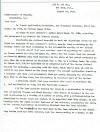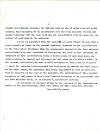|
W.J.
Sidis Archives
Photo
of Calendar Geprodis
Org. News, No.7 Print
Your Own
|
PERPETUAL CALENDAR
U. S. Patents
1,718,314 and 1,784,177
June 25, 1929;
December 9, 1930
In US
Index of Patents, 1929, 658-660; 1930,
638 - 640.
|
UNITED
STATES PATENT OFFICE
__________________
WILLIAM JAMES SIDIS, OF
NEW YORK, N. Y.
PERPETUAL CALENDAR
Original application
filed December 15, 1927, Serial No. 240,214.
Divided and this application filed June 13, 1929.
Serial No. 370,713.
This application is a division of my
application No. 240,214, filed December 15, 1927, Patent No. 1,718,314, June 25,
1929.
The invention relates to perpetual
calendars in which week-days can be found directly for any given date whatever;
and its object is, first, to provide a means by which all such week-days can be
looked up in a direct, simple and easily understandable manner; secondly, to
avoid the cross-reference tables or complex mechanism, one or the other of which
have hitherto generally been features of perpetual calendars providing means to
look up the week-day of any given date whatever; thirdly, to provide a perpetual
calendar which, once the calendar is adjusted for any given year, a complete and
condensed calendar for the year is at once plainly visible; fourthly, to
simplify the parts and their interrelation by the elimination of indicators or
pointers which add both to the difficulty and expense of manufacture and to the
derangement of the operation of the calendar.
The invention is illustrated in the
two figures of the accompanying drawing, the front sheet or card being
represented in Fig. 1, and the disk forming the remainder of the calendar being
represented in Fig. 2.
The essential features of the
calendar are a front sheet or card (see Fig. 1), and a disk (see Fig. 2), these
two parts being attached to one another by means of a pivot or other rotating
device whereby the disk may be made to rotate freely about a suitable fixed
point of the front sheet.
The said disk consists of two concentric sections, the center being the pivot or
axis about which the disk rotates; these two sections are the month-section (1)
and the year-section (2).
The month-section consists of twenty-four or more sectors, each containing the
name of a month or a set of such names. At least thirteen of such sectors shall
contain the names of months arranged in the cyclical order of the week-days on
which they begin in leap-years; and at least thirteen of such sectors shall
contain the names of months arranged in the cyclical order of the week-days on
which they begin in non-leap-years; when several months in a leap-year, in
a non-leap-year, as the case may be, begin on the same week-day, all such months
are in the same sector.
The year-section (2) shall consist of a group of leap-years (3) in seven
sectors, and a group of non-leap-years (4) in seven sectors, the sectors
comprising each the same angle about the common center of the disk as the
month-sectors. These sectors correspond to the month-sectors separated from them
by the same angle of the disk's arc that separates the initial edge of the
year-slot (5) from that of the month-slot (6).
All the years within a definite period (in this case 1900 to 1956) are
placed in one of the fourteen sectors mentioned in the preceding paragraph such
year being placed in the leap-year or non-leap-year sectors according as it is
or is not a leap-year; and each year further being placed in the sector
corresponding to the months beginning in that year on the week-day (Sunday in
the instance illustrated) found in the first row and first column of the
week-day group (7) on the front sheet.
The front sheet (see Fig. 1) of the calendar has two perforations, a month-slot
(6) under which the month-section (1) of the disk rotates, and disclosing
seven sectors of said month-section; and a year-slot (5) of such shape and size
that, when properly adjusted, it discloses just one sector of the year-section
(2) of the disk, said sector being that corresponding to the first month-sector
visible through the month-slot.
Upon the front sheet of the calendar also is a group of week-days (7) arranged
in seven rows and seven columns so that in each row and in each column the seven
days of the week appear in the cyclical order in which they occur, and so that
the continuations of the seven rows fit the seven month-sectors visible through
the month-slot (6) when the disk is properly adjusted; also a group of
date-numbers (8) from 1 to 31, occupying the continuation of the seven week-day
columns, the said numbers being listed in
succession, row by row.
In addition, the front sheet of the calendar should contain a conversion-table
(9), stating how many years have to be added or subtracted in order to use the
calendar for years not listed in the year-section (2) of the disk.
The pivot (10), or any other similar rotatory device, furnishes a means whereby
the disk may be rotated behind the front sheet so that the year desired will
appear through the year-slot (the conversion-table being used in the case
of years not within the period covered on the disk). When this is done, the
months appearing through the month-slot, and the week-days and date-numbers on
the front sheet, constitute a complete and condensed calendar for the year in
question, the week-day for any date appearing in the same row as the month, and
the same column as the date.
I claim:
The combination, in a perpetual calendar, of a disk containing the months
properly grouped in sectors and the years occupying sectors of the same disk in
a concentric ring; a front sheet with two slots making visible respectively
the month-sectors and a year-sector, and containing week-days in seven rows
and seven columns, and date-numbers occupying a continuation of those seven
columns; with a pivot by means of which the disk may be rotated at will
with reference to the front sheet.
WILLIAM JAMES SIDIS








|
112 W.119 St.,
New York, N.Y.,
August 23, 1930.
Commissioner of Patents,
Washington, D.C.
Dear Sir:-
Re Patent Application No. 392,411, for
Perpetual Calendar, filed September, 13, 1929, by William James Sidis.
In reply to your examiner's letter dated March
17, 1930, rejecting the above-named application for letters patent.
Amendments are enclosed herewith to meet the
objections stated in the first two sections of your examiner's letter,
namely, that pertaining to the sliding device and that pertaining to the
alternative wording of two claims.
I hereby submit that your examiner erred in
rejecting the claims on my former patent No.1,718,314 (June 25, 1929),
for the reason that the present application differs from that described
in the claim of the patent mentioned in more than the mere change in
structure from a disk to a sliding form. The claim in Patent No.
1,718,314 specifies as an essential part of the device claimed therein
"an indicator...rotating with the disk, which can be made at will
to point to any year listed on the front sheet." The present
application describes a calendar with this part eliminated, thus not
merely changing the structure from disk to sliding form, but eliminating
an important part of the device.
I similarly submit that your examiner also erred
in rejecting the patent application on Ross, for the following reasons:
(1) The Ross calendar denotes the years by a
combination in tabular form of century figures and final figures. This
device is replaced in the previous application by a listing of a number
of years, with a reference-table for directions to handle years not
listed. It is submitted that this change, in combination with the other
general features of the calendar, constitutes the device in the present
application an invention distinct from the Ross calendar.
(2) The tabular form for week-days in the Ross
calendar is one disclosing twelve rows and seven columns, each row
corresponding to a month. In the present application, however, the
tabular form is one of seven rows and seven columns, thus amounting to
an improvement over the Ross calendar whereby all months beginning with
the same week-day are consolidated into the same row (or column) of
week-days on the calendar.
(3) It is submitted that the reversal of parts
itself is more than a mere reversal of parts in the present instance,
inasmuch as the specification in the Ross patent discloses that the
arrangement adopted in the Ross calendar necessitates a special
treatment of leap-years, the said special treatment as disclosed in that
specification being a double entry of each leap-year, one entry applying
to January and February, and the other to all other months. In the
present application, no such special treatment of leap-years is required
or used, the calendar being operated for leap-years in exactly the same
manner as for other years, the operation thus being simplified so that
no such caution is required of the user of the calendar. The elimination
of this special treatment of leap-years is thus a simplification
amounting to an improvement over the Ross calendar which, it is
submitted, constitutes novelty.
An amendment is enclosed adding to the purposes
of the invention as stated in the specification, which will bring out
this point more clearly.
Respectfully yours,
|

|







